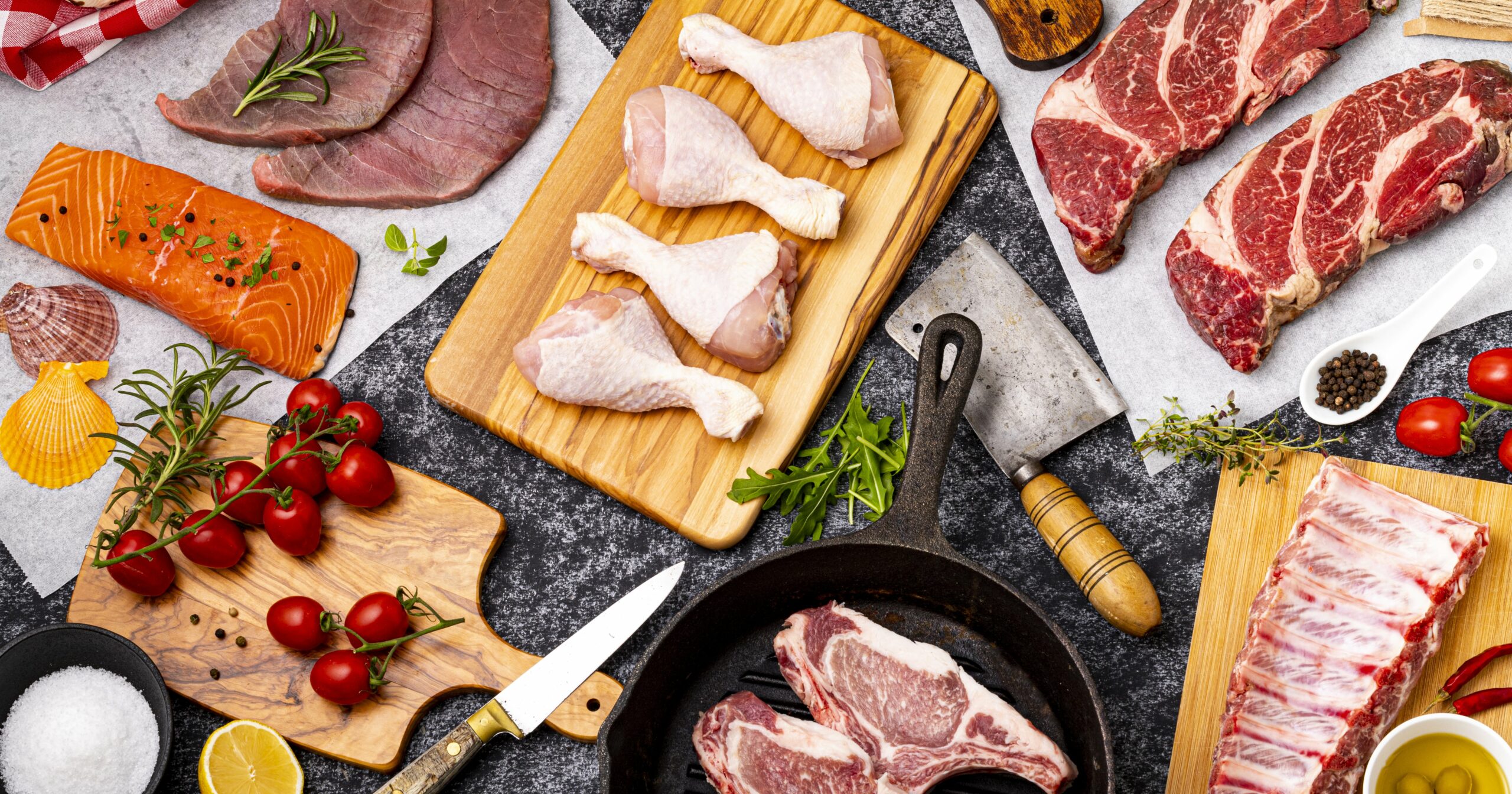Carnivores, omnivores, and flexitarians, this one is for you. From sinking your teeth into a juicy steak or savoring the perfectly roasted chicken drumstick, eating meat is a common part of many diets. And among the many nutrients meats can provide, protein seems to get the most attention.
“Protein is needed for several reasons,” says registered dietitian, Lisa Andrews, MEd, RD. “We need protein to create hormones, enzymes, and neurotransmitters. It’s also needed to make DNA and transport proteins.” Additionally, “studies show that high-protein diets also promote satiety, which can help curb hunger and support sustainable weight loss,” says registered dietitian, Melissa Mitri, MS, RD, registered dietitian and owner of Melissa Mitri Nutrition.
Although protein can be sourced from several foods, from legumes to whole grains to even veggies, meat products are by far the most protein-packed. As the FDA suggests approximately 50g of protein for the average adult – and as Americans, particularly men aged 19-59 are often far exceeding this suggestion – it’s important to ensure that your meat sources are protein-rich while also providing a slew of other nutrients that can aid in different aspects of your health.
If you are wondering which meat has the most protein, get your knife ready and keep reading to find out which top the list for registered dietitians, myself included!
Meats With the Most Protein
If you’re looking to increase your protein intake via meat, this list should help. From t-bone steak to pork, here’s a list of meats with the most protein, organized from highest to lowest. We broke the nutrients information down per 100g, according to the US Department of Agriculture (USDA).
1. T-Bone Steak
Per 100g: 212 calories, 11.4g fat (4.68g sat fat), 67mg sodium, 0g carbs (0g fiber, 0g sugar), 27.3g protein
A juicy T-Bone steak clocks in at number one on the protein scale with a whopping 27.3g of protein per 100g serving. Anyone who enjoys a good steak knows that the T-Bone is one of the most delicious cuts. But why is it so good? It’s one of the fattier cuts of steak right behind the New York strip and skirt steak. So, although you’re getting ample amounts of protein – over half a day’s worth – it’s important to note that too much red meat consumption, especially fattier cuts, can lead to health risks like heart disease.
2. Yellowfin Tuna
Per 100g: 109 calories, <1g fat (<1g sat fat), 45mg sodium, 0g carbs (0g fiber, 0g sugar), 24.4g protein
This fish is a great option for those who want protein density with a boost of healthy fats, as seafood is one of the best sources of DHA omega-3 fatty acids. With 24.4g of protein per 100g serving, Yellowfin Tuna provides nearly half of your daily protein needs with only 45mg of sodium which is optimal as the American Heart Association recommends that the average adult doesn’t exceed 1,500mg of sodium per day. Of course, many consumers are concerned about rising mercury levels in big fish like tuna, so it’s important to buy from trusted brands, such as SafeCatch, that have strict mercury monitoring systems and transparency.
3. Shrimp
Per 100g: 99 calories, <1g fat (<1g sat fat), 111mg sodium, <1g carbs (0g fiber, 0g sugar), 24g protein
Who doesn’t love a good shrimp dish? (That is, unless you have a shellfish allergy, of course). Shrimp is a versatile little crustacean as it has a mild yet meaty flavor without any unwanted fats and high-calorie counts. With a whopping 24g of protein per serving, shrimp are protein-packed and simultaneously provide essential nutrients such as potassium which regulates heartbeat and can aid in lowering blood pressure. Additionally, shrimp provides iodine that aids in cognitive functions, but is often overlooked.
4. Chicken Drumsticks
Per 100g: 149 calories, 5.95g fat (1.6g sat fat), 117mg sodium, 0g carbs (0g fiber, 0g sugar), 23.9g protein
When reaching for chicken, if you’re going to grab a piece and looking for the most protein, opt for the dark meat. What, exactly, is dark v. light meat? Dark meats (aka, the thighs and drumstick) have more of what’s known as myoglobin which promotes oxygen and blood flow and gives the meat that reddish-brown coloring. While it is true that dark meat is a bit higher in fat as compared to light meat (breast) options, it does contain a bit more protein with 23.9g of protein per serving. Outside of protein desires though, both dark and light meat chicken still has far fewer calories than other meats, so at the end of the day, it really boils down to personal taste preferences.
5. Chicken Breast
Per 100g: 106 calories, 1.93g fat (<1g sat fat), 66mg sodium, 0g carbs (0g fiber, 0g sugar), 22.5g protein
Chicken breast is perhaps the most widely eaten meat on the market as it’s easily accessible, neutral in flavor, and relatively healthy as compared to other meat options. Chicken breast is also a great source of protein coming in at 22.5g, but it’s also rich in other nutrients including selenium which is packed with antioxidants, Vitamin B6 which may aid in assuaging depression symptoms, and the lesser-known mineral phosphorus which works with other minerals like calcium to help prevent bone density loss and osteoporosis. Really, you can’t go wrong with a chicken breast, just try not to douse this drier meat in additives such as butter or fried batters.
6. Rabbit
Per 100g: 114 calories, 2.32g fat (<1g sat fat), 50mg sodium, 0g carbs (0g fiber, 0g sugar), 21.8g protein
Depending on your taste preferences and where you live in the country, you may or may not be a rabbit consumer. Still, we wanted to throw this option on our list as rabbit contains a surprising amount of protein with very low fat counts and sodium levels. With only 50g of sodium per serving and under 3g of fat, rabbit is a leaner meat that goes great in stews and stir-fries. Rabbit meat is high in both selenium and vitamin B-12, the latter of which is essential for red blood cell formation, and proper consumption can ward of B-12 deficiency which can result in a slew of health issues including fatigue, gastrointestinal issues, and even change your skin tone to a yellowish tinge.
7. Wild Atlantic Salmon
Per 100g: 142 calories, 6.34g fat (<1g sat fat), 44mg sodium, 0g carbs (0g fiber, 0g sugar), 19.8g protein
Salmon is certainly a healthier protein choice as it’s lower in fat, sodium, and calories. In recent years, its popularity has skyrocketed as it can be cooked in various ways for different taste profiles and goes great with a medley of veggies. Salmon is also an impressive source of Omega-3 fatty acids (aka, EPA and DHA) which can aid in preventing cardiovascular disease, and some studies show a correlation between Omega-3 fatty acids and a lower rate of cognitive decline – in layman’s terms, this nutrient may help stave off dementia.
8. Ground Chuck Beef
Per 100g: 232 calories, 17.8g fat (6.34g sat fat), 48mg sodium, 0g carbs (0g fiber, 0g sugar), 18.4g protein
As with other beef products, ground chuck is higher in fat than other sources of protein, yet each serving provides 18.4g of protein. Many people have shied away from eating too much red meat which may be for the best as too much red meat can lead to health issues such as an increased risk of type-2 diabetes. However, red meat does provide essential nutrients such as iron with ground chuck providing 2.06mg of iron per serving. Iron is vital for proper red cell production, and a whopping 40% of young women in America have iron deficiency which can lead to a slew of issues including intense fatigue and decreased cognitive performance.
9. Ground Turkey
Per 100g: 153 calories, 9.59g fat (2.26g sat fat), 80mg sodium, 0g carbs (0g fiber, 0g sugar), 17.3g protein
Like many meats on this list, turkey is a great choice for both protein and nutrients like selenium. Additionally, turkey is packed with HDL – or “good” cholesterol – which aids in carrying “LDL (bad) cholesterol away from the arteries and back to the liver where the LDL is broken down and passed from the body,” as explained by the American Heart Association. As many people find turkey to be a drier meat, be on the lookout for added oils and even sugary toppings like artificial cranberry sauce before devouring. You want to make sure you’re doing your body justice by fueling it with healthy proteins and less of the bad stuff.
10. Pork
Per 100g: 228 calories, 17.5g fat (6.28g sat fat), 54mg sodium, 0g carbs (0g fiber, 0g sugar), 17.8g protein
It may not be surprising to folks that pork comes in last on our protein list and contains one of the highest fat counts behind ground beef chuck. Pork is often far tastier than other meats and can offer you ample protein when consumed in moderate portions, but remember that many processed meats like sausage and salami are made from pork products and have an associated cancer risk. Whether or not you feel it to be an alarmist move, the WHO has even declared processed meat to be a carcinogen. So just remember that, as with everything, eat pork in moderation and you should be a-okay.
Which Meat Has the Most Protein?
When it comes to which meat has the highest protein concentration per average serving, the T-Bone steak certainly takes the cake with 27.3g per serving. Of course, we’re not telling you to go out and eat three steaks a day. Moderation is your best friend when it comes to the consumption of red meat. Aim for around 3-4 oz per serving, Mitri says.
What Meat Has the Most Protein and Least Fat?
Many healthcare providers will agree that the most all-around nutritious meat source is the tried-and-true chicken breast which boasts “8 grams of protein in just 1 ounce, [and] also packs essential nutrients, such as B vitamins, zinc, and vitamin A that your body needs to function optimally,” says Mitri. Not only is chicken a good option nutritionally, but chicken is relatively inexpensive and compliments many dishes that suit a variety of taste pallets.
“Chicken can be added to salads, soups, and sandwiches or used on its own as part of a meal. It can [also] be seasoned many different ways,” says Andrews. Chicken can easily be made unhealthy, though, especially as you add in salt, douse it in toppings, and even fry it (we know, it’s delicious, but it simply isn’t great for your arteries). Therefore, try to up the flavor game with your sides by including whole grains and EVOO roasted veggies on the side.
How to Incorporate High-Protein Meat Into Your Diet in a Healthy Way
It’s important to remember that every body is different and no two lifestyles are the same. It makes sense that a smaller, relatively sedentary adult would need less protein than, say, an Olympic athlete. But no matter your needs, there are a few rule-of-thumb guidelines that will help you consume meat in a healthy way.
A serving of meat is three to four ounces – or about 100g, which is around the size of a deck of cards. Most people typically consume more than this, Andrews points out. But one way to stick to the recommended portion size of meat without feeling deprived (because seeing a 3-ounce steak on your plate when you are used to eating a ten-ouncer can feel sad) is by making dishes that require pieces of meat that are mixed with other ingredients. For example, stir fry or a salad that is made with 3 ounces of meat looks like a “fuller” dish than a standalone three-ounce piece of meat on a plate.
Furthermore, consider the cooking method. Grilling, baking, or broiling can be healthful choices that avoid extra calories. Pair these meaty treats with plenty of vegetables, whole grains, and legumes to round out your meal, ensuring you’re not only feasting on protein but also harvesting the benefits of a varied diet rich in essential nutrients. Try and lean on nutrient-dense sides, too, like sautéed veggies and whole grain farro or rice instead of more refined choices.




